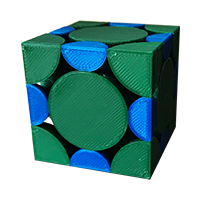Crystallography Resources
3D Printer Files of Unit Cells and Ionic Compounds
The 3D printer files (Wavefront OBJ files) for all of the fundamental structures and binary ionic compounds found on the CrystalViz site are provided below. For the ionic compounds separate files are given for cation and anion. These can be combined using the slicer/prep program for any given 3D printer.



Fundamental Structures
Binary Ionic Compounds
- cesium chloride: cesium, chloride
- sodium chloride: sodium, chloride

- sodium chloride (shifted): sodium, chloride
- nickel arsenide: nickel, arsenide
- sphalerite (ZnS): zinc, sulfide
- antifluorite (Na2O): sodium, oxide
- wurtzite (ZnS): zinc, sulfide
Olex2
Olex2 is an excellent tool for small-molecule structure solution and refinement. Here is a (somewhat dated) quick reference sheet that can help when learning some of the Olex2 commands. An excellent set of notes on Olex2 is maintained by Ilia Guzei (UW Madison).
SJML’s Chemistry (Crystallography) Scripts
It can be challenging to get some standard crystallography software working properly on a Mac. This page includes a set of notes and scripts that help automate the process of installing SHELX (note: registration required), getting SHELX to work with Olex2, and installing and updating Platon. Highly recommended for users at all levels.
Cambridge Structural Database
Perhaps the single most useful combination of software and data for teaching structural chemistry and crystallography is the Cambridge Structural Database produced by the Cambridge Crystallographic Data Centre. The combination of over 1.1 million crystal structure data sets with powerful software to search, visualize and analyze structural data can be very useful in an educational setting. A great set of papers has been published in the Journal of Chemical Education that highlight the many educational applications of the CSD.
- Learning about Intermolecular Interactions from the Cambridge Structural Database, Gary M. Battle and Frank H. Allen, Journal of Chemical Education 2012 89 (1), 38-44.
- Teaching Three-Dimensional Structural Chemistry Using Crystal Structure Databases. 4. Examples of Discovery-Based Learning Using the Complete Cambridge Structural Database, Gary M. Battle, Frank H. Allen, and Gregory M. Ferrence, Journal of Chemical Education 2011 88 (7), 891-897.
- Teaching Three-Dimensional Structural Chemistry Using Crystal Structure Databases. 3. The Cambridge Structural Database System: Information Content and Access Software in Educational Applications, Gary M. Battle, Frank H. Allen, and Gregory M. Ferrence, *Journal of Chemical Education 2011 88 (7), 886-890.
- Teaching Three-Dimensional Structural Chemistry Using Crystal Structure Databases. 2. Teaching Units That Utilize an Interactive Web-Accessible Subset of the Cambridge Structural Database, Gary M. Battle, Frank H. Allen, and Gregory M. Ferrence, Journal of Chemical Education 2010 87 (8), 813-818.
- Teaching Three-Dimensional Structural Chemistry Using Crystal Structure Databases. 1. An Interactive Web-Accessible Teaching Subset of the Cambridge Structural Database, Gary M. Battle, Frank H. Allen, and Gregory M. Ferrence, Journal of Chemical Education 2010 87 (8), 809-812.
- Using the Cambridge Structural Database To Teach Molecular Geometry Concepts in Organic Chemistry, Jay Wm. Wackerly, Philip A. Janowicz, Joshua A. Ritchey, Mary M. Caruso, Erin L. Elliott, and Jeffrey S. Moore Journal of Chemical Education 2009 86 (4), 460.